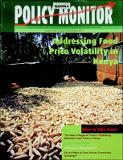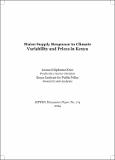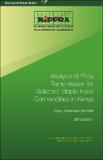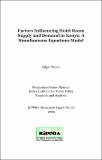| dc.date.accessioned | 2021-07-02T09:33:37Z | |
| dc.date.available | 2021-07-02T09:33:37Z | |
| dc.date.issued | 2012 | |
| dc.identifier.uri | http://repository.kippra.or.ke/handle/123456789/3024 | |
| dc.description.abstract | Kenya is a low-income country
with a GOP per capita estimated
at USS 775. Agriculture is a major
economic activity. Currently, one out
of every four Kenyans suffers from
chronic food insecurity and poor
nutrition. Several factors are responsible
for high food prices in Kenya. On the
supply side, rapid and significant
seasonal fluctuations in supply, and
high global petroleum prices, have
led to increased costs related to local
food production and supply. On the
demand side, population growth has
also outstripped food production in
most parts of the country. Moreover;
liberal trade policies have also
contributed to food price volatility. Policy interventions to address
food price volatility include: adoption of
yield increasing technologies;
increasing access to affordable
inputs; increasing production
of traditional high-value foods;
encouraging peri-urban
agriculture; empowering
farmers with relevant
information and management
skills to run these institutions
efficiently; and ensuring a favourable legal, institutional
and political framework for
these institutions to thrive. | en |
| dc.language.iso | en | en |
| dc.publisher | The Kenya Institute for Public Policy Research and Analysis (KIPPRA) | en |
| dc.relation.ispartofseries | Policy Monitor Issue 5, No.1 2012; | |
| dc.subject | Food prices | en |
| dc.subject | Food stability | en |
| dc.subject | Price volatility | en |
| dc.subject | Kenya | en |
| dc.title | Policy Monitor, Issue 5 No. 1, July-December 2012 on Addressing Food Price Volatility in Kenya | en |
| dc.type | KIPPRA Publications | en |
| ppr.contributor.author | The Kenya Institute for Public Policy Research and Analysis (KIPPRA) | en |




